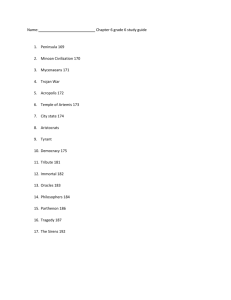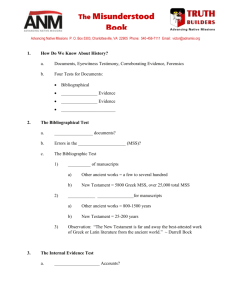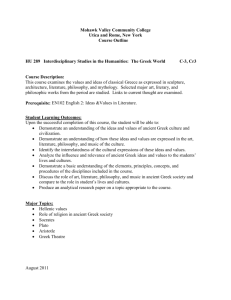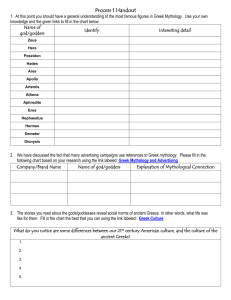Class IV: New Testament Textual Criticism
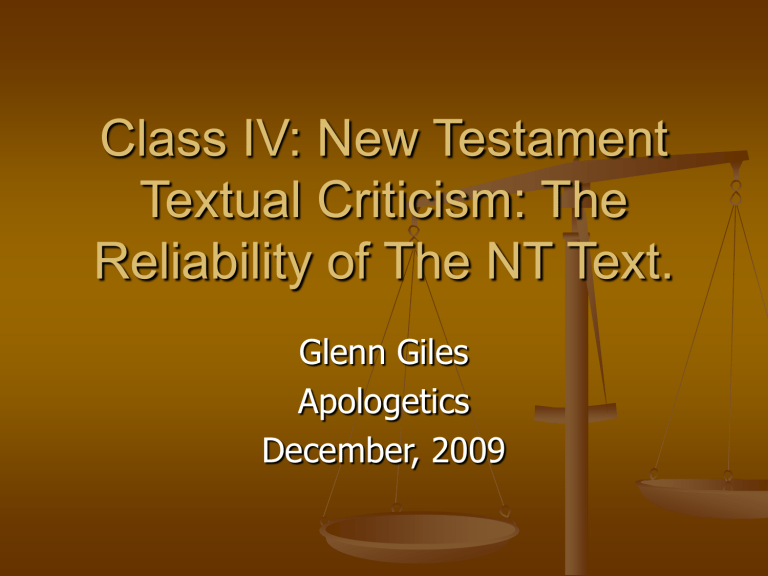
Class IV: New Testament
Textual Criticism: The
Reliability of The NT Text.
Glenn Giles
Apologetics
December, 2009
NT Greek MSS Textual Criticism
A. Definition of Textual Criticism:
“Textual criticism is the study of copies of any written work which the autograph (the original) is unknown, with the purpose of ascertaining the original text”
(Greenlee, 1, see class notes for all references in this ppt).
B. Goal of New Testament Textual Criticism:
When applied to the New Testament, it has the task of attempting to restore the original text of the New Testament Greek documents
(Briggs, 31).
The Need For
NT Greek Text Criticism
C. The Need:
1. There are no extant original documents
(whole or part) of any New Testament book.
2. While the text of the NT is over 95% certain
(Briggs, 51), there are still “roughly three hundred
thousand variant readings” from copyist errors in the “5500 Greek MSS and perhaps nine thousand versional MSS.”
(McKnight and Osborne, 59).
Bible Times Book/Scroll
Preparation
D. Biblical times book/scroll preparation and writing
1. Ancients used clay (Ezek. 4:1), Stone
(Ex. 31:18), and wood tablets, leather scrolls (Jer. 39:23).
2. In later times they used papyrus
(paper made from papyrus reed, its inner bark extracted and dried).
Bible Preparation
3. Also, used parchment/vellum (small animal skins), scrolls (see II Tim. 4:13).
4. Scrolls were papyrus, leather, or parchment sheets joined together in long rolls, about 10-12 inches wide and up to 35 feet long with 3-4 inch columns. Sometimes writing was on both sides
(Rev. 5:1; Ezek. 2:10).
5. The Codex (a book of papyrus sheets) was also used by the mid First Century AD.
Bible Preparation
6. Writing of NT Greek MSS had very little punctuation, no paragraph divisions, no sentence divisions, and no spaces between words.
--This made copying without errors very difficult. Copying mistakes were made frequently. But no errors have been found that are theologically significant.
Examples of Types of Errors Found
--The following were facilitated by the lack of spaces between letters and words in writing and copying the Greek texts and could be called
“sight errors”.
Omissions (haplography)
Duplications (dittography)
Jumping from the “same letter or group of letters to another” at the beginning of a word (homoioarcton), or at the middle of a word (homoiomeson), or at the end of a word
(homoioteleuton) (McKnight, 61).
Change of the order of words (metathesis)
Three Major
MSS Families Discovered
1. Alexandrian text witnesses: These have the earliest and best quality of MSS and considered by scholars to be the
“best” MSS.
2. Western text witnesses have an “early but generally unreliable form of the text”
(Green. 135)
MSS Families
3. Byzantine text witnesses “which include the vast majority of later manuscripts, are the most universally judged by scholars to preserve an inferior form of the text”
(Green. 135).
King James Verson (Textus Receptus) is of this family. The King James Debate supporters opt for this “majority” text reading to be the inspired one. But does majority=accuracy
--On this see D. A. Carson,
Baker, 1979).
The King James
Debate: A Plea For Realism (Grand Rapids:
The Reliability of the NT
Four witnesses supporting the integrity of the New
Testament text.
1.
Oral Tradition Verbatim Memorization
Techniques of the Day
--A Scandinavian Scholar, Birger Gerhardsson, in his book called Memory and Manuscript: Oral Tradition and written Transmission in Rabbinic Judaism and Early
Christianity translated by Eric J. Sharpe (Lund, Sweden: C. W. K. Gleerup, 1961) shows how rabbis in the memory techniques to their disciples which enabled them to heard. second remember verbatim century AD taught teaching they had
Oral Tradition Kept From Error
Gerhardsson shows evidence that the rabbis of the first century AD probably had access to these techniques also.
This gives support to the possibility of Jesus’ disciples being able to remember (not even considering the inspiration of the Holy Spirit!) verbatim what Jesus said and thus writing down exactly what they heard.
Unlike in today’s world, they had trained themselves how to listen and retain information accurately.
Argues against assumptions of Form Criticism
Ancient Greek NT Manuscripts
2. The Testimony of Ancient Greek Manuscripts.
--There are over 5000 existing Greek Manuscripts of the
New Testament or portions of it.
--They all speak to the reliability of the New Testament.
--There are very few differences and those that exist are not theologically significant.
--In fact there are so many manuscripts that one can trace different families of manuscripts and find when a variant occurred.
--These manuscripts span a time period of from 125AD to the end of the middle ages.
NT Text Criticism Greek MSS
(1)
John Rylands Manuscript (125-130AD).
--Found in Egypt.
--Measures “only 3.5 by 2.5 inches (8.9 by 6 cm) at its widest; and conserved with the Rylands
Papyri at the John Rylands University Library
The front contains lines from the Gospel of
John 18:31–33, in Greek , and the back contains lines from verses 37–38”
(From Wikipedia)
--It is important in that the Gospel of John can no longer be dated by liberal scholars at 200AD.
They once dated it this late to account for
John’s so called “developed theology.”
NT Greek Papyri
(2) Chester Beatty Papyri (200-
300AD).
--This contains major portions of the New
Testament, including portions of the
Gospels and Acts, the Catholic Epistles, 10 of Paul’s letters and the Book of
Revelation.
Ancient Greek NT MSS
(3) Bodmer Papyrus II (150-200AD).
This contains John’s Gospel.
(4) Diatesseron, a harmony of the Gospels by Tatian (AD160).
Ancient Greek NT MSS
(5) Codex Sinaiticus (350AD): Aleph ( a )
--Contains all the New Testament except Mk.
16:9-20 and Jn. 7:53-8:11.
--It was found in 1844 in a Mt. Sinai (Traditional site) monastery.
--It was found in a waste basket where monks there had been using old manuscripts as firewood to keep warm!
--It was discovered by Tischendorf and is now in
London.
Ancient Greek NT MSS
(6) Codex Vaticanus (325-350AD): B
--Housed in the Vatican library
--contains nearly all the Bible (OT and NT) but omits the book of Revelation.
(7) Codex Alexandrinus (400AD):A.
--It is in the British Museum.
--Contains most of the NT and OT. It contain Revelation.
does
Greek NT MSS
(8) Codex Ephraemi (400s AD):C.
--Housed in Paris
--it contains every NT book except II
Thessalonians and II John.
--It contains much of the OT.
--History: About the 12th century it was broken up and only 208 leaves survive. These leaves had been erased and rewritten with something else.
But with the use of chemical agents they are able with some difficulty to read and reconstruct the original writing on much of the codex.
Ancient NT Greek MSS
(9) Codex Bezae (450+ AD).
--Housed in Cambridge
--contains the Gospels, Acts, and the Catholic epistles in Greek and Latin (Greek on left, Latin on right).
(10) Codex Washingtonensis (450-550AD). –
--Contains the 4 Gospels.
(11) Codex Claromontanus (500s AD).
--Housed in Paris it contains Pauline epistles.
NT Text Integrity
When compared to other ancient writings, support for the New Testament text
integrity
is incredibly abundant
Note the following chart from Josh
McDowell’s book
Evidence that Demands a
Verdict
, 48. Compare these ancient writings and see which one you would conclude has the best attestation for the original text.
NT And Other
Ancient Writings Compared
AUTHOR WHEN WRITTEN EARLIEST COPY TIME SPAN # OF COPIES
Caesar 100-44BC 900AD 1000 years 10
Plato 427-347BC 900AD 1200 years 7
Tacitus 100AD 1100AD 1000 years 20
Suetonius 75-160AD 950AD 800 years 8
Herodotus 480-425 BC 900 AD 1300 years 8
NT And Other
Ancient Writings Compared
Sophocles 496-406 BC 1000 AD 1400 years 100
Euripides 480-406BC 1100 AD 1500 years 9
Aristotle 384-322BC 1100AD 1400 years 5
Aristophanes 450-385BC 900 AD 1200 years 10
NT 49-96AD 125AD 30-75 yrs 5000+
Which one would you choose for having integrity in determining the original text?
The Testimony of Ancient
Versions/Translations.
3. The Testimony of Ancient
Versions/Translations.
--There are in existence over 9,000 copies of early versions (translations) of the NT.
--These all give witness to the Greek text.
The Testimony of Ancient
Versions/Translations.
(1)
Syriac Peshitta Version (400s AD)—
--translated about 150-250AD.
--There exist more than 320 extant manuscripts of this version.
--There is also an Old Syriac Version copied about 300-400 AD which contains the four Gospels
Ancient Versions
(2) Old Latin Versions including the
Latin Vulgate by Jerome (366-384AD).
(3) Coptic (Egyptian) Versions including
Sahidic which dates to the early 3rd century
(4) Armenian Version (From the 5th century AD)
Ancient Versions
(5) Ethiopic Versions (From the 5th century AD)
(6) Georgian Versions (From the 5th century AD)
(7) Old Slavonic (From the 9th century
AD).
Early Church Father’s Quotations
d. The Testimony of the Early Church
Fathers.
--There are over 37,000 quotations from the New Testament in Greek from the early church leaders/fathers which speak to the reliability of the New Testament and its integrity.
Early Church Father’s Quotations
(1) Clement of Rome (90-100AD). He quotes much from Paul and other NT writers.
(2) Ignatius, Bishop of Antioch (70-110AD).
He quotes from 15 NT Books.
(3) Polycarp, a disciple of John the Apostle
(70-156AD).
(4) Justin Martyr (133AD) has 330 quotes from the NT
Early Church Father’s Quotations
(5) Clement of Alexandria (150-220AD) has
2,406 quotes from all but 3 NT books.
(6) Irenaeus, Bishop of Lyons (170-200AD) has 1,819 NT quotes.
(7) Tertullian (160-220AD) has 7,258 quotes/references to the NT.
(8) Origen (185-254AD) has 17,922 quotes of the
NT
Early Church Father’s Quotations
(9) Hippolytus (170-235AD) has 1,378 NT quotes
(10) Cyprian (d. 258AD) has over 1000 NT quotes
(11) Eusebius (330AD) the early church historian quotes 5,176 times from the NT.
Significance of These Four
Witnesses to the NT Text
Frederick Kenyon (an authority on the NT text) says,
“It cannot be too strongly asserted that . . . the text of the
Bible is certain: Especially is this the case with the New
Testament. The number of manuscripts . . ., of early translations from it, and of the quotations from it in the oldest writers of the church, is so large that it is practically certain that the true reading of every doubtful passage is preserved in some one or other of these ancient authorities. This can be said of no other ancient book in the world”.
[1]
[1] (Josh McDowell, Evidence that Demands a Verdict, vol. 1, 45).
Examples of Discovered
Variants in the Text
1. Acts 8:37. Omitted by Aleph, A, B, C. and papyrus P47 (3rd century AD). King
James has this verse because it was based on later manuscripts which had included this. One of the earliest manuscripts which include this is dated about the 6th century
AD
Some NT Variants
2. John 5:3b-4. Not in the earliest mss: P46
(2nd-3rd century), P75 (3rd century), Aleph, B,
C, D and others. A (5th century) includes it.
3. John 7:53-8:11. Omitted by P66 (2nd-3rd century), p75 (3rd century), Aleph, A, B, C, and others. It is included in D (5th or 6th century). -
-Some later mss place it after Luke 21:38, or Lk.
24:53, or Jn. 7:36, or Jn. 21:25. It seems to have been a floating story which some felt should be in the Bible and so placed it there.
Some NT Variants
D. Mark 16:9-20. Not found in the earliest mss. Might have been a lost end or originally in a book that lost its cover (and first and last pages). It is omitted by Aleph and B (4th century mss). Is found in A, C, D (5th and
6th century MSS). This ending is a long ending.
--There also exists a shorter ending. See the NASB which gives the following as an alternate ending after verse 8:
“And they promptly reported all these instructions to
Peter and his companions. And after that, Jesus Himself sent out through them from east to west the sacred and imperishable proclamation of eternal salvation.”
NT Greek Text Criticism Results
The text of the NT is virtually certain
Of the variants found, there are no theologically significant ones that change the basic tenants of Christianity.
New Greek Texts with Apparatus have been published with the variants for everyone to study.
Two NT Greek Texts
1. UBS Greek Text
--Apparatus
A= Text is certain
B= Text is almost certain
C= There is difficulty deciding which variant is the correct one
D= There is great difficulty in arriving at which variant is the correct one (used very rarely)
2. Also there is a Nestle-Alan Greek Text with different apparatus.
Greek Texts As a Result of NT
Textual Criticism
1. Novum Testamentum Graece , 27th edition, edited by
Eberhand Nestle, Kurt Aland, and Barbara Aland
(Stuttgart: Duetsche Bibelgesellschaft, 1993).
2. United Bible Societies’ The Greek New Testament 4th
Revised Edition, edited by Barbara Aland, Kurt Aland,
Johannes Karavidopoulos, Carlo M. Martini, and Bruce M.
Metzger (Stuttgart: Duetsche Bibelgesellschaft, 1993).
This was produced specifically for Bible translators.
3. For further study see Bruce M. Metzger, The Text of the
New Testament: Its Transmission, Corruption, and
Restoration (4th Edition) (New York: Oxford, 2005).
